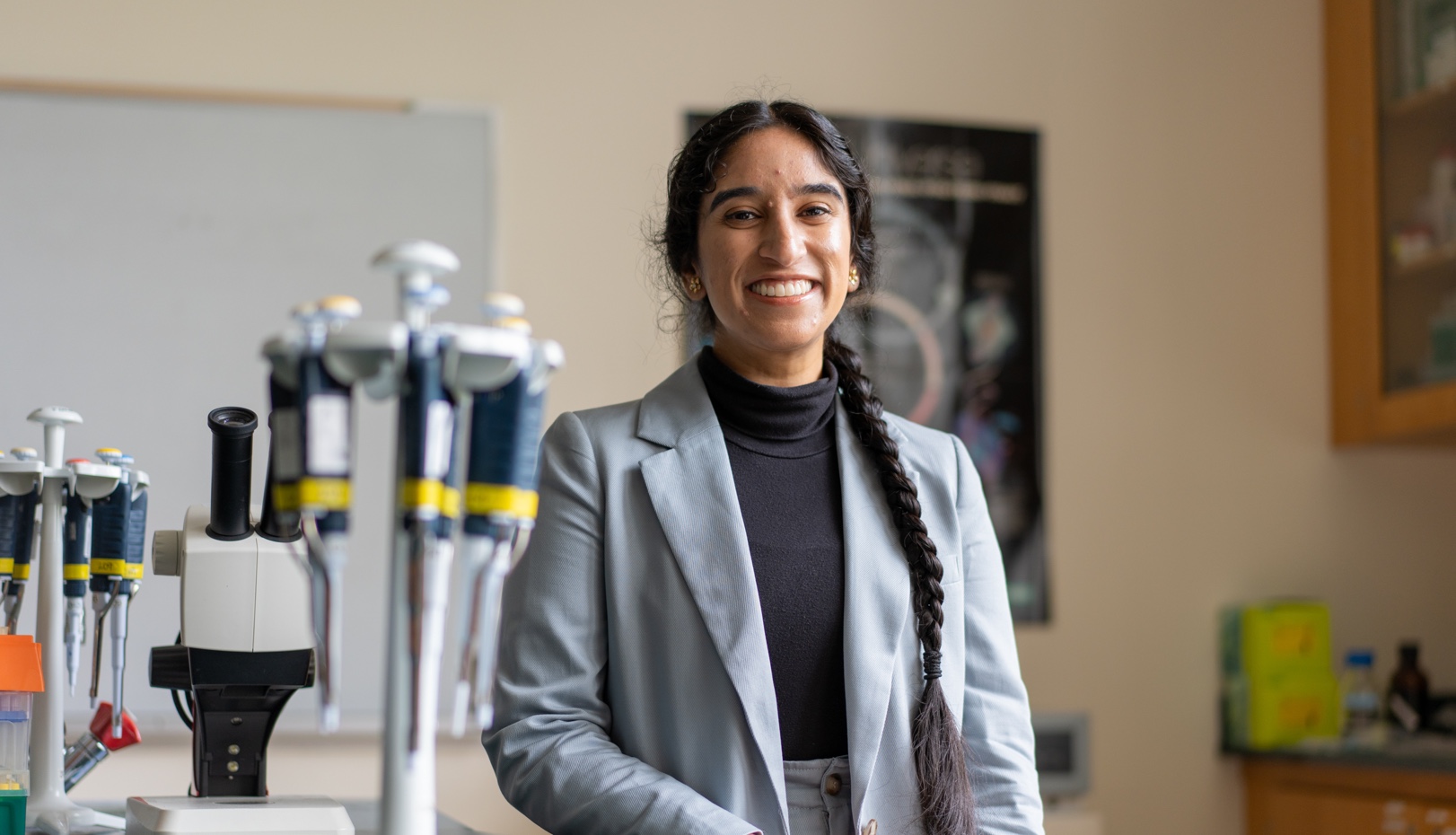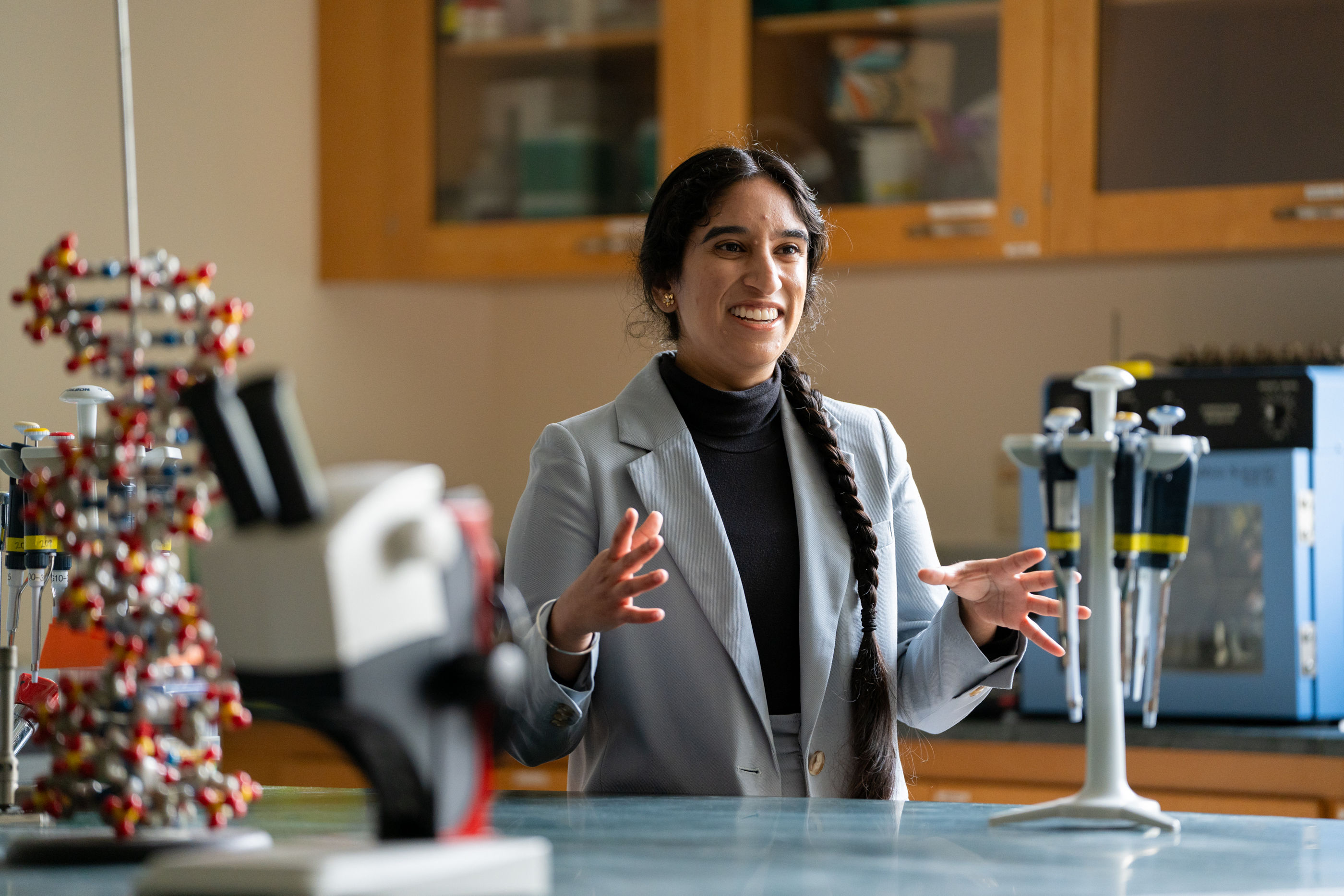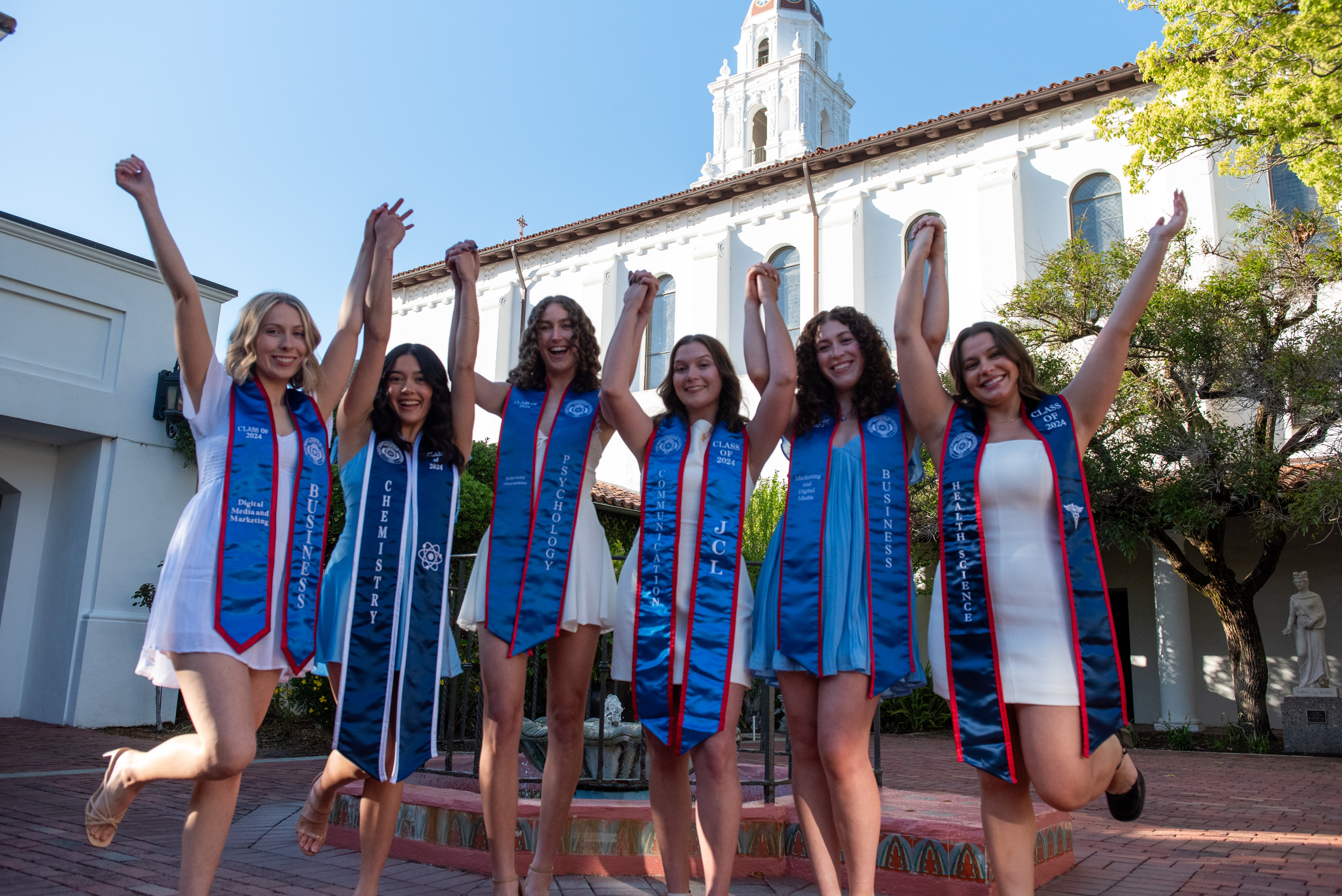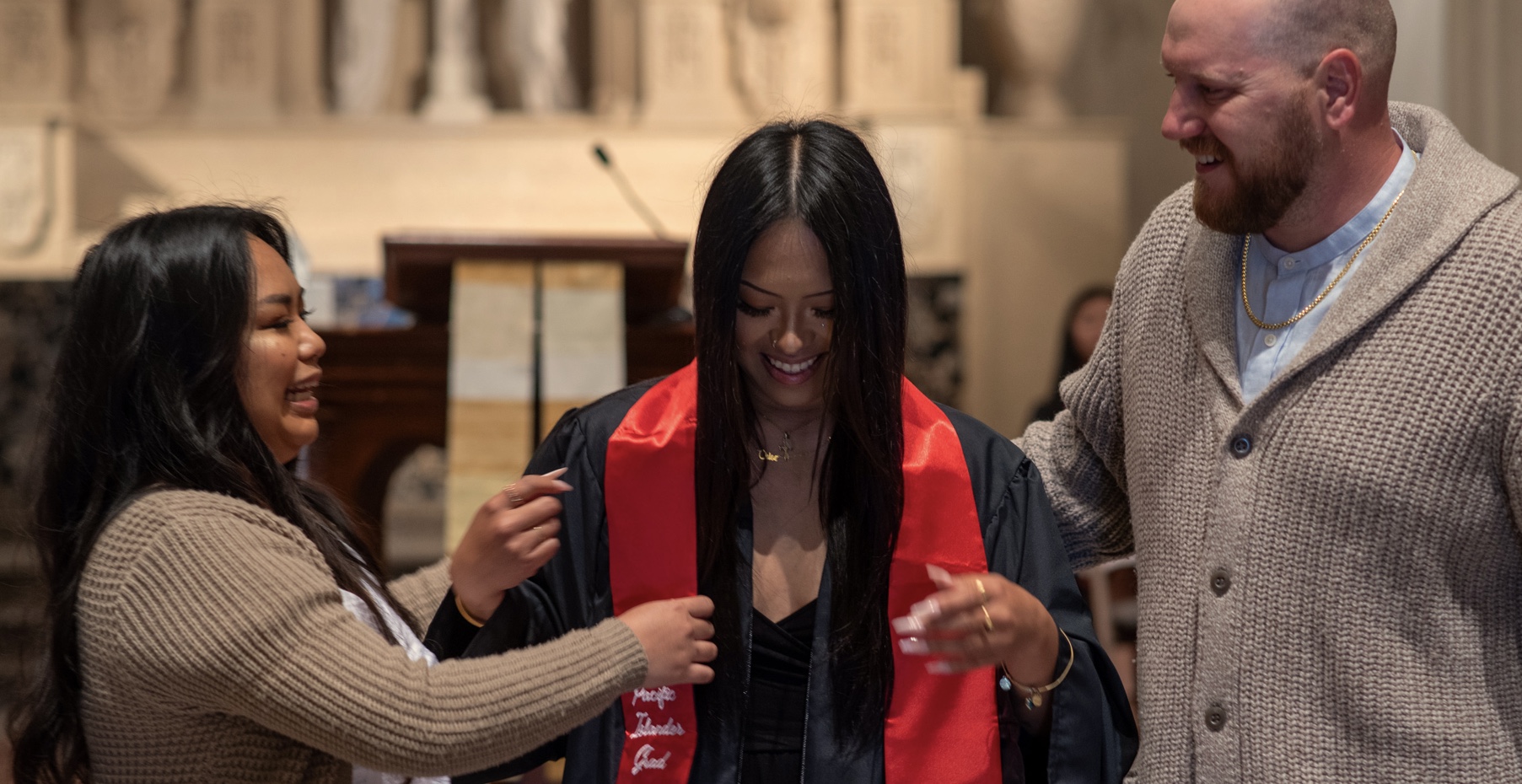
Sahiba Kaur Dogra ’24 is the first in her family to pursue scientific research. She points to the doctors and specialists she encountered as a child as inspiration: "Growing up, they were my heroes." / Photo by Francis Tatem
De La Salle Award-Winner Sahiba Kaur Dogra ’24 Believes that Curiosity Fuels Change
She’s the winner of the College’s highest honor, along with two top-tier awards from the School of Science. Next up? A career in biomedical research, helping to treat rare or previously incurable conditions like her own.
Science has always been personal for Sahiba Kaur Dogra ’24. A Biology major and Data Science minor, her fascination with immunology, genetics, and biomedicine began with trying to understand herself.
As an infant, Dogra was diagnosed with Eosinophilic Esophagitis, or EoE: a rare genetic disorder that makes eating most solid foods difficult. Growing up, she was in and out of hospitals regularly. Her diet consisted of seven foods: plantains, bananas, opo squash, peanuts, cauliflower, broccoli, and rice. Still, she’s always approached her body with “curiosity,” she says. “There were things on an invisible, microscopic scale that made such a large impact on my daily life. I just wanted to know why.”
In 2023, while a student at Saint Mary’s, Dogra was approved for a therapeutic drug that changed all of that. Suddenly, she had the opportunity to explore an array of new food options and experiences. Today, she plans to pursue a career in biomedicine, hoping to offer the same kind of transformation to others.
Dogra has certainly made her mark during her four years at SMC. She’s the recipient of this year’s De La Salle Award, presented annually to one graduating student with the highest record for academic and general excellence. Alongside Valedictorian, it’s the most significant honor the College offers.
She also received both the Arthur S. Campbell and the Carlos Freitas Awards, which recognize the senior with the most outstanding scholastic record in the School of Science (SOS) and Biology program, respectively. For Alice Baldridge, interim dean of SOS, Dogra represents exceptional academic achievement while also embodying that quintessential Saint Mary’s ethos: Enter to learn, leave to serve.
“Sahiba desires to understand the intricacies of her illness, in order to, as she once wrote, ‘encourage change, growth and healing for people living with incurable, rare and debilitating disorders,’” Baldridge says. “I’ve been impressed with her reflection on her own growth as a student, scholar, and whole person during her time at Saint Mary’s.”
Breaking Ground

When Dogra and I talk in late April, we meet in a place she knows well: a lab classroom on the second floor of Brousseau Hall. She considers herself an introvert, but is effusive and articulate, especially when it comes to genetics. At one point, she gestures to a plastic model of a double helix atop a supplies cabinet. “I’ve never seen that move in my entire four years here,” she jokes. (We eventually make history, pulling it down for our photo shoot.)
Dogra comes from a family of detail-oriented difference-makers. Her mother is a social worker, and her father manages artificial intelligence projects for Amazon. Her older brother—classically trained in Indian Classical violin —just completed his master’s in composition.
“I’m the first in my close family to pursue research,” she acknowledges. For her, the interest in Biology began with the doctors and specialists she encountered at the Cincinnati Children’s Hospital. “Growing up, they were my heroes.”
Back when Dogra was considering colleges, she was immediately drawn to SMC because of its proximity and size. A commuter, she wanted to find a campus that would feel like home, even while living with her family in San Ramon. “I knew I would get lost at a big university,” she says. “I really wanted that close-knit environment, where you get to know everybody, and it’s just really supportive.”
Alongside the support and relationships, she quickly found opportunities to research a plethora of subjects. In 2021, through the School of Science Summer Research Program, she worked alongside Professor of Biology Kai Blaisdell, discovering numerous aphid-spread viruses on the trees of SMC’s Bertrain Redwood Grove.

The next summer, she secured a competitive internship at the renowned Sandia National Laboratories, researching probiotic and prebiotic treatments for pathogenic bacteria. Then, in 2023, she interned at the SENS Research Foundation, a Mountain View-based facility that funds groundbreaking anti-aging science.
Through all of these opportunities, as well as through courses with Professor of Biology Vidya Chandrasekaran or with Associate Professor Rashaan Meneses MFA ’06, who taught her in Collegiate Seminar, Dogra came to see how scientific curiosity could catalyze change, especially for marginalized populations. Living with EoE, she knows what it is like to be overlooked.
“Biology is one thing,” she says. “But when you can use biology to make a difference, it’s something else entirely.”
Cascading Success
For Dogra, her most meaningful research came in 2022. That May, she was stunned to learn that the FDA had approved Dupixent—an anti-inflammatory drug previously used for eczema—as the first treatment for EoE. “When I heard the news, it seemed like a dream,” she later wrote. “I have been told for the past 20 years that my disease is incurable.”
As overjoyed as she was, the scientist in her soon kicked in. She knew how uncommon EoE is; out of 333 million Americans, she was one of an estimated 152,152 with EoE. That’s around .04 percent. “Rare diseases don’t get a lot of funding…I was like, Okay, how did you come up with a therapeutic for this?”
Dogra decided to find out. A member of the Honors Program at Saint Mary’s, she is required to complete three independent research projects called Contracts in order to graduate with the Honors distinction. Working with Professor of Biology Anthony Talo, she devoted her second Contract to unpacking how Dupixent came to be.
“Something I've learned while here at Saint Mary's is that you want patients to feel like they're living their best life...Anything I can do to support that would be the dream.”
The project would eventually become an award-winning essay published in Saint Mary’s interdisciplinary journal Spectrum. A central analogy of Dogra’s paper is the “domino effect”: just as there is “cascade of molecular reactions” that causes EoE in herself and others, so one scientific discovery propels forth another, and another, and another.
The Human Genome Project, for instance, was critical for EoE researchers at the Cincinnati Children’s Hospital—the same researchers who treated Dogra as a child. Through it, they obtained the world’s first comprehensive map of DNA. This allowed them to pinpoint the dysregulated genes that brought an excess of eosinophils (a type of white blood cell) to the esophagus. By learning about those genes, researchers were able to discover that Dupixent would also be helpful for people with EoE.
In other words, the dominoes fell. “One thing leads to the next,” she says. “All of these intersecting factors eventually create success for so many patients like me.”

Empowering the Patient
In Fall 2023, Dogra was approved for Dupixent herself. Suddenly, at age 22, she went from eating seven core foods to almost everything—save dairy, eggs, and a few other foods. For the first time, she could eat out at vegan restaurants.
To some carnivores, that may still sound limiting. But for her, she emphasizes, it’s liberating. “Honestly, being able to eat out at a restaurant is still a very new experience for me!” (She’s eager for recommendations, by the way.)
Her final semesters at Saint Mary’s have been packed with new experiences. She’s currently the president of the DiverseAbilities Club, a student organization dedicated to educating the SMC community about disability issues and hosting events and spaces for differently abled Gaels. Notably, this past year, DiverseAbilities had its most active year yet on campus, and it was recognized as the Student Organization of the Year at an awards ceremony earlier this month.
In late April, Dogra learned she had won the De La Salle Award as well as the two top-tier SOS awards. “When I heard, I was in a state of shock,” she says. “I still am, I think.” She credits her peers and professors with supporting and encouraging her. “I just feel so loved by the Saint Mary’s community. It really validates my four years here and everything I put into it.”
As for what’s next, she’s planning on graduate school, although not immediately. Mostly, she wants to find a job in a biomedical lab in the Bay Area and get to work.
In years to come, she could help cure the incurable. But ultimately, she tells me, it’s people—their wants, their hopes—that will guide her. “Something I've learned while here at Saint Mary's is that you want patients to feel like they're living their best life,” she tells me. “That may or may not include a therapeutic."
“It's all about empowering the patient,” Dogra continues. In her voice, I can hear, perhaps, the same calm, compassionate intonations she first heard from the Cincinnati doctors she encountered as a child. “Anything I can do to support that would be the dream.”
Hayden Royster is Staff Writer at the Office of Marketing and Communication for Saint Mary's College. Write him.


